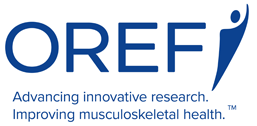

Manish S. Noticewala, MD
OREF/TAF Resident Research Project Grant
Research Topic
Developed, tested and validated a new instrument to evaluate pain, function, and performance in youth baseball players.
Patient Impact
An outcome questionnaire that better assesses youth overhead athlete’s pain function and performance.
Outcome Instrument Improves Care for Youth Overhead Athletes
OREF grant recipient Develops outcome instrument to evaluate shoulder and elbow injuries in young athletes
Mark Crawford, OREF contributing writer
More than 2.6 million emergency department visits are made every year for sports-related injuries in the 5 to 24-year-old age group. As more young athletes play organized sports, the rate of pediatric sports injuries continues to rise.
Clinical outcome instruments that are both pediatric-specific and injury-specific are needed to objectively evaluate the effect of an intervention on recovery from injury. Currently there are no validated upper extremity—shoulder and elbow—instruments designed to evaluate pain, function, and performance in the pediatric overhead athlete.
“There is very little in the literature regarding how to evaluate these patients and assess the efficacy of treatments,” said Manish S. Noticewala, MD, an orthopaedic surgeon conducting sports medicine research at Columbia University Medical Center in New York City. “For example, if a 12-year-old overhead athlete comes in with elbow pain, how can you quantify his/her pain and functional limitations? How can the orthopaedic surgeon objectively determine whether the treatment intervention led to an improvement in pain and function?”
Thus, there is a strong need for a rigorously developed outcome instrument for youth overhead athletes. This is especially true for youth and adolescent baseball players, who suffer increasing numbers of shoulder and elbow injuries.
To solve this problem, Dr. Noticewala, under the mentorship of Christopher S. Ahmad, MD, received an OREF/The Aircast Foundation Resident Research Project Grant, funded by The Aircast Foundation, to develop such an instrument. The research project, entitled “Pain, Function, and Performance Assessment in the Overhead Youth Athlete,” was carried out from July 2015 to June 2016. Results were published in the February 2017 issue of the American Journal of Sports Medicine.
The resulting “Youth Throwing Score”—the first available validated outcome instrument assessing pain, function, and performance in youth baseball players—“can potentially be utilized in both clinical practice and clinical research as an objective way to assess youth baseball players following injury and/or treatment,” said Dr.Noticewala.
Developed by a panel of experts
The objective of this study was to develop an outcome assessment instrument with rigorously tested psychometric properties, such as reliability, validity, and responsiveness, targeted to children and adolescent overhead athletes. The purpose of the instrument is to assess and validate upper extremity injuries in young baseball players by evaluating pain, function, and performance.
“We hypothesized that the Youth Throwing Score [YTS] will be more reliable, valid, and responsive than other patient-derived outcome instruments administered to more normally distributed, general populations, such as the Disabilities of the Arm, Shoulder, and Hand [DASH] questionnaire or the Pediatric Outcomes Data Collection Instrument [PODCI],” said Dr. Noticewala.
Dr. Noticewala assembled a panel of experts to generate potential questions for the instrument. Participants included orthopaedic surgeons, a pediatrician, certified physical therapists, athletic trainers, and coaches. Instructions were given to develop items that were neither sport-specific nor joint-specific. The list was reviewed and a preliminary questionnaire developed. The preliminary questionnaire was then administered to 202 youth baseball players to assess any issues involving readability, comprehension, interpretation, visibility, and formatting.
“We didn’t ask them to just fill out the questionnaire, but to also provide feedback about the questions,” said Dr. Noticewala. “For example, is this a question they understand? How would they change this question to make it more applicable? After receiving their feedback, we went back to the clinicians and actually reworded some of the questions and eliminated others.”
The final YTS questionnaire was administered to a group of adolescent patients. This cohort also filled out the DASH and PODCI questionnaires and Dr. Noticewala and his research team compared results of all three instruments.
Discussion and outcome
A total of 223 baseball players (mean age, 14.3 years) completed the final survey. Pilot analysis showed that none of the 14 questions received a mean athlete importance rating less than three of five, and the final survey read at a Flesch-Kincaid level of 4.1, which is appropriate for patients aged 9 years and older. The athletes self-assigned their injury status. Out of a possible score of 70, the mean instrument score was 59.7 for the 148 athletes “playing without pain,” 42.0 for the 60 athletes “playing with pain,” and 40.4 for the 15 athletes “not playing due to pain.” Athletes playing without pain scored significantly higher than those playing with pain and those not playing due to pain. Injured players scored an average of 9.4 points higher after treatment, and those who improved in their self-assigned pain category scored an average of 16.5 points higher.
A detailed statistical analysis showed strong internal consistency, test-retest reliability, responsiveness, and content validity in addition to moderate correlations with other validated instruments. Because all design constructs were met, the YTS was confirmed as a validated outcomes measure for injury assessment of young throwers.
“The Youth Throwing Score is the first valid and reliable instrument for assessing young baseball players’ upper extremity health,” said Dr. Noticewala. “The instrument can be utilized in both clinical practice and clinical research as an objective means to assess youth overhead athletes following injury and/or treatment.”
Dr. Noticewala is quick to point out that this research would not have been possible without OREF funding.
“We needed every single dollar of our grant to complete the research,” he said. “The grant process itself is a useful learning experience for someone trying to become a clinician scientist. The data obtained from the Youth Throwing Score will hopefully be used to create evidence-based treatment algorithms for conditions that currently do not have consensus treatment guidelines. Such impact will fulfill the OREF’s mission of enhancing clinical care, leading to improved health, increased activity, and better quality of life for patients."
Mark Crawford is a contributing writer for OREF. He can be reached at communications@oref.org.
